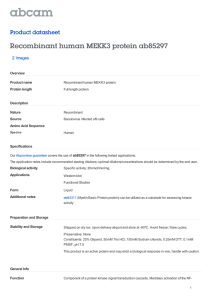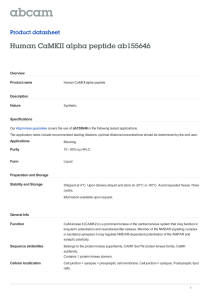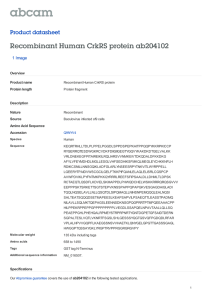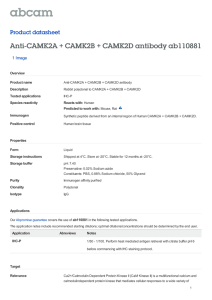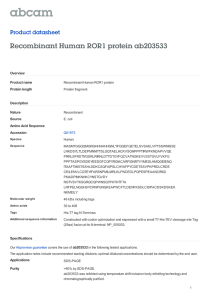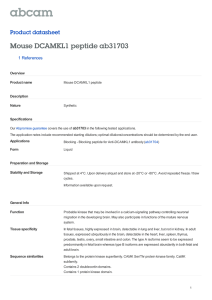Characterization of Sporulation-Specific Clostridium perfringens Bryan Danielson, Mahfuzur Sarker, Ph.D.
advertisement
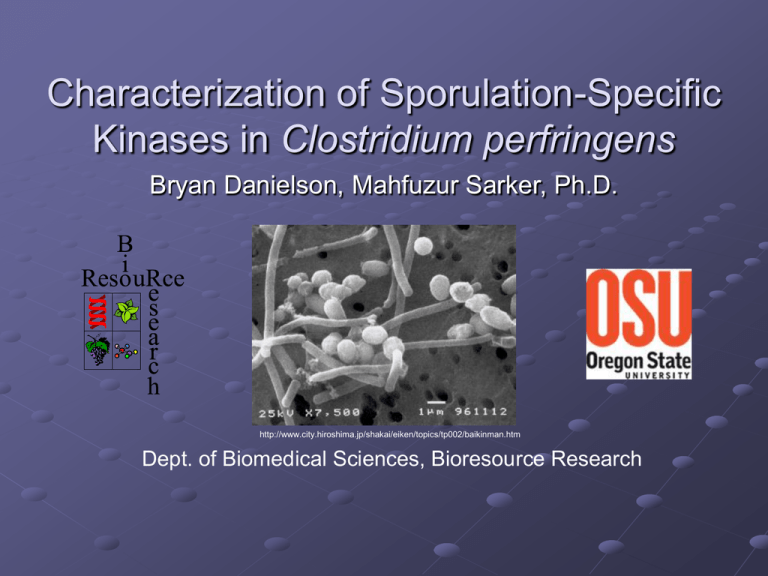
Characterization of Sporulation-Specific Kinases in Clostridium perfringens Bryan Danielson, Mahfuzur Sarker, Ph.D. http://www.city.hiroshima.jp/shakai/eiken/topics/tp002/baikinman.htm Dept. of Biomedical Sciences, Bioresource Research Overview Background Basis for project Methods and Results Conclusions Future experiments Background Clostridium Ancient genus Gram + Rod-shaped Anaerobic Spore-formers Sporulating C. perfringens Clostridium species C. difficile C. tetani http://www.emedicine.com/med/topic3412.htm http://textbookofbacteriology.net/clostridia.html C. botulinum C. acetobutylicum http://nabc.ksu.edu/content/factsheets/category/Botulism http://www.accessexcellence.org/LC/SS/ferm_graphics/reactor.html C. perfringens Reservoir: (ubiquitous) • Soil, water, intestinal tract of humans and animals Produces heat-resistant spores Commonly contaminate foods Remain viable after cooking C. perfringens Causes disease in humans and animals through two routes: 1. Via damaged skin: Clostridial myonecrosis (gas gangrene) 2. Via gastrointestinal (GI) tract: 1. Food-borne 2. Antibiotic-associated 3. Sporadic Toxins 15 different toxins Each isolate produces only a subset Isolates classified by production capabilities of 4 toxins Toxinotyping Toxins C. perfringens toxinotypes Type α-toxin β-toxin ε-toxin ι-toxin A + B + + C + + D + E + + + + Type A Food Poisoning Third most reported bacterial food poisoning in the United States Estimated to cause: 250,000 cases/year $120 million losses/year Symptoms: Appear 8-12 hours post ingestion Acute abdominal pain, diarrhea Persist ~24 hours Type A Food Poisoning Conditions that promote food spoilage: Slow cooling after cooking and/or storage of cooked food at warm temperatures Danger zone: 70° – 120°F (20° - 50°C) Primary sources for outbreaks: Banquets, cafeterias Heating trays Large quantities of food Meat, and meat-containing dishes Generally high-protein foods C. perfringens enterotoxin: CPE Major virulence factor for type A food poisoning Damages epithelium of small intestine Healthy Diseased Production of CPE is sporulation-specific Type A Food Poisoning Spore Contamination Cooking Slow cooling and/or storage at moderate temperature Germination Disease cycle Environment GI illness Ingestion Rapid proliferation Type A Food Poisoning ≥107 cells consumed Cells sporulate in small intestine CPE is released http://www.drugdevelopmenttechnology.com/projects/cilanserton/cilanserton7.html Spores leave through diarrhea Project Basis Project Basis Production of CPE is sporulation-specific Block sporulation block CPE production Medical field Therapeutics Food industry Natural inhibitory additives Safe handling procedures Sporulation Pathway How is Spo0A activated? Spo0A 1. Receipt of signal 2. Activation of Spo0A 1. ? 2. 3. 3. Gene regulation 4. Sporulation 4. CPE Spore Components in B. subtilis Phosphorelay in Bacillus subtilis: Gene sequence similarity: Signal X Spo0B 6 orthologues X Spo0F ~P Not present ~ kinase ~P P Spo0A ~P (Present) Central Hypothesis One or more kinases bypass intermediate phosphate messengers to directly activate Spo0A Signal Kinase~P X Spo0F X Spo0B Spo0A Candidate Kinases 6 kinase candidates: CPE 0986 CPE 1512 CPE 0213 CPE 1754 CPE 1986 CPE 1316 2 selected for project Objective Evaluate whether expression of cpe0213 and cpe1754 is necessary for sporulation to occur Methods and Results Project Plan Assess kinase transcriptional activity Inactivate each gene to make kinase mutants Complement mutants with functional kinase gene Kinase Transcriptional Activity: Reverse Transcriptase PCR (RT-PCR) Reverse Transcription (RT)-PCR Purpose: Transcriptionally active in sporulating conditions Steps: Propagate in sporulation-inducing media: Duncan-Strong (DS) Isolate total RNA Reverse transcribe kinase mRNAs to cDNA Amplify kinase cDNA via polymerase chain reaction (PCR) Data: RT-PCR + Positive Control RT Test + RT - CPE 1754 + RT - - Negative Control CPE 0213 Conclusion: cpe0213 and cpe1754: 1. Are transcriptionally active 2. Are transcribed in sporulating conditions Gene Inactivation Gene Inactivation Purpose: Evaluate sporulation in kinasedeficient mutants Steps: Construct a mutator plasmid Transform the plasmid into C. perfringens Select for putative mutants Gene Inactivation Mutator plasmid: 1. Kinase gene fragment pCR®-XL-TOPO® (Invitrogen) 2. Chloramphenicol (Cm) resistance cassette 1. 400-500 bp Kinase ORF Cm 2. Gene Inactivation Transformation: Electroporation Cm Chromosome Single crossover: Gene inactivation Cm Gene Inactivation Selection for chloramphenicol resistance Brain-Heart Infusion Agar plates http://www.emdchemicals.com Sporulation Assay Sporulation induced by 8-hr growth in DS media Vegetative cells and spores enumerated with a microscope counting chamber http://www.hawksley.co.uk Sporulation Assay Frequency (ν) = [spores] / [spores + cells] Relative frequency = [mutant ν] / [wild type ν] Sporulation in cpe0213 mutant Sporulation in cpe1754 mutant Repetition Relative Frequency Repetition Relative Frequency 1 0.32 1 0.25 2 0.25 2 0.50 3 0.24 3 0.30 Average = 0.27 Average = 0.33 Statistical Analysis Data for sporulation assays was analyzed with a two-sample t-test: Degrees of freedom: 4 p<0.01 Statistical analysis indicates a significant decrease in sporulation frequency for the kinase mutants with 99% confidence Complementation Complementation Purpose: to verify that disruption of the target gene caused the decrease in sporulation Steps: Construct a complementation vector Transform vector into kinase mutants Select for transformants Complementation Complementation vector: 3. OriCp 1. Functional kinase gene 2. Erythromycin resistance (Em) pJIR751 1. 3. Origin of replication for C. perfringens 2.0 - 2.7 kb Kinase ORF Promoter region 2. Em Complementation Transformation: electroporation Vector Propagation Complementation 1. Transformants were selected for by growth in erythromycin and chloramphenicol 2. Sporulation frequency was evaluated 3. Sporulation frequency was compared to mutant sporulation frequency Complementation Result: No increase in sporulation frequency Complement wild type: Severe reduction in sporulation capability Reliable sporulation assays could not be performed due to sporulation deficiencies Possible Reasons The complementation vectors are multicopy. This may lead to an overproduction of the kinase A negative feedback system may be triggered to block all production of the kinase The overproduced kinase may hinder activity of kinase(s) involved in sporulation Conclusions Conclusions cpe0213 and cpe1754 are transcribed in the presence of a sporulation signal cpe0213 and cpe1754 mutants exhibit a reduced sporulation frequency cpe0213 and cpe1754 mutants could not be complemented Future Experiments Experiments to evaluate the other 4 candidate kinases In vitro phosphorylation assays Overproduction and purification of Spo0A and kinase Future Experiments Construct stable kinase mutants Single crossover inactivation technique is reversible Traditional Double-crossover inactivation TargeTron™ Gene Knockout System (Sigma-Aldrich) Acknowledgments The Sarker Lab: Dr. Mahfuzur Sarker I-hsiu Huang Dr. Deepa Raju Daniel Paredes-Sabja Nahid Mahfuz Marcelo Mendez John Clarke Dr. Dan Rockey Bioresource Research: Wanda Crannell Dr. Kate Field Undergraduate Research Innovation Scholarship and Creativity (URISC) Oregon State University Questions?


